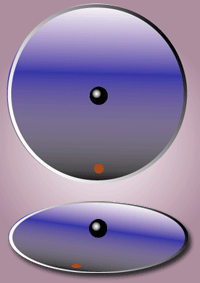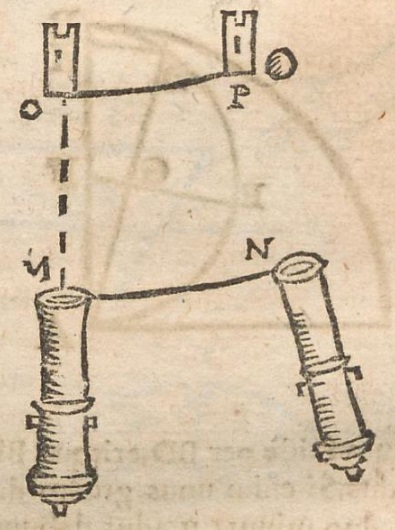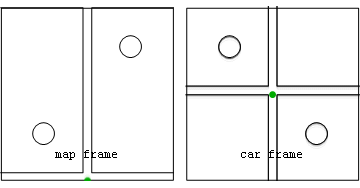|
Euler Acceleration
In classical mechanics, the Euler force is the fictitious tangential force that appears when a non-uniformly rotating reference frame is used for analysis of motion and there is variation in the angular velocity of the reference frame's axes. The Euler acceleration (named for Leonhard Euler), also known as azimuthal acceleration or transverse acceleration is that part of the absolute acceleration that is caused by the variation in the angular velocity of the reference frame. Intuitive example The Euler force will be felt by a person riding a merry-go-round. As the ride starts, the Euler force will be the apparent force pushing the person to the back of the horse; and as the ride comes to a stop, it will be the apparent force pushing the person towards the front of the horse. A person on a horse close to the perimeter of the merry-go-round will perceive a greater apparent force than a person on a horse closer to the axis of rotation. Mathematical description The direction and ... [...More Info...] [...Related Items...] OR: [Wikipedia] [Google] [Baidu] |
Classical Mechanics
Classical mechanics is a physical theory describing the motion of macroscopic objects, from projectiles to parts of machinery, and astronomical objects, such as spacecraft, planets, stars, and galaxies. For objects governed by classical mechanics, if the present state is known, it is possible to predict how it will move in the future (determinism), and how it has moved in the past (reversibility). The earliest development of classical mechanics is often referred to as Newtonian mechanics. It consists of the physical concepts based on foundational works of Sir Isaac Newton, and the mathematical methods invented by Gottfried Wilhelm Leibniz, Joseph-Louis Lagrange, Leonhard Euler, and other contemporaries, in the 17th century to describe the motion of bodies under the influence of a system of forces. Later, more abstract methods were developed, leading to the reformulations of classical mechanics known as Lagrangian mechanics and Hamiltonian mechanics. These advances, ... [...More Info...] [...Related Items...] OR: [Wikipedia] [Google] [Baidu] |
Fictitious Force
A fictitious force is a force that appears to act on a mass whose motion is described using a non-inertial frame of reference, such as a linearly accelerating or rotating reference frame. It is related to Newton's second law of motion, which treats forces for just one object. Passengers in a vehicle accelerating in the forward direction may perceive they are acted upon by a force moving them into the direction of the backrest of their seats for example. An example in a rotating reference frame may be the impression that it is a force which seems to move objects outward toward the rim of a centrifuge or carousel. The fictitious force called a pseudo force might also be referred to as a body force. It is due to an object's inertia when the reference frame does not move inertially any more but begins to accelerate relative to the free object. In terms of the example of the passenger vehicle, a pseudo force seems to be active just before the body touches the backrest of the sea ... [...More Info...] [...Related Items...] OR: [Wikipedia] [Google] [Baidu] |
Rotating Reference Frame
A rotating frame of reference is a special case of a non-inertial reference frame that is rotating relative to an inertial reference frame. An everyday example of a rotating reference frame is the surface of the Earth. (This article considers only frames rotating about a fixed axis. For more general rotations, see Euler angles.) Fictitious forces All non-inertial reference frames exhibit fictitious forces; rotating reference frames are characterized by three: * the centrifugal force, * the Coriolis force, and, for non-uniformly rotating reference frames, * the Euler force. Scientists in a rotating box can measure the speed and direction of their rotation by measuring these fictitious forces. For example, Léon Foucault was able to show the Coriolis force that results from Earth's rotation using the Foucault pendulum. If Earth were to rotate many times faster, these fictitious forces could be felt by humans, as they are when on a spinning carousel. Relating rotating frames ... [...More Info...] [...Related Items...] OR: [Wikipedia] [Google] [Baidu] |
Angular Velocity
In physics, angular velocity or rotational velocity ( or ), also known as angular frequency vector,(UP1) is a pseudovector representation of how fast the angular position or orientation of an object changes with time (i.e. how quickly an object rotates or revolves relative to a point or axis). The magnitude of the pseudovector represents the ''angular speed'', the rate at which the object rotates or revolves, and its direction is normal to the instantaneous plane of rotation or angular displacement. The orientation of angular velocity is conventionally specified by the right-hand rule.(EM1) There are two types of angular velocity. * Orbital angular velocity refers to how fast a point object revolves about a fixed origin, i.e. the time rate of change of its angular position relative to the origin. * Spin angular velocity refers to how fast a rigid body rotates with respect to its center of rotation and is independent of the choice of origin, in contrast to orbital angular ... [...More Info...] [...Related Items...] OR: [Wikipedia] [Google] [Baidu] |
Frame Of Reference
In physics and astronomy, a frame of reference (or reference frame) is an abstract coordinate system whose origin, orientation, and scale are specified by a set of reference points― geometric points whose position is identified both mathematically (with numerical coordinate values) and physically (signaled by conventional markers). For ''n'' dimensions, reference points are sufficient to fully define a reference frame. Using rectangular Cartesian coordinates, a reference frame may be defined with a reference point at the origin and a reference point at one unit distance along each of the ''n'' coordinate axes. In Einsteinian relativity, reference frames are used to specify the relationship between a moving observer and the phenomenon under observation. In this context, the term often becomes observational frame of reference (or observational reference frame), which implies that the observer is at rest in the frame, although not necessarily located at its origin. A rela ... [...More Info...] [...Related Items...] OR: [Wikipedia] [Google] [Baidu] |
Leonhard Euler
Leonhard Euler ( , ; 15 April 170718 September 1783) was a Swiss mathematician, physicist, astronomer, geographer, logician and engineer who founded the studies of graph theory and topology and made pioneering and influential discoveries in many other branches of mathematics such as analytic number theory, complex analysis, and infinitesimal calculus. He introduced much of modern mathematical terminology and Mathematical notation, notation, including the notion of a function (mathematics), mathematical function. He is also known for his work in mechanics, fluid dynamics, optics, astronomy and music theory. Euler is held to be one of the greatest mathematicians in history and the greatest of the 18th century. A statement attributed to Pierre-Simon Laplace expresses Euler's influence on mathematics: "Read Euler, read Euler, he is the master of us all." Carl Friedrich Gauss remarked: "The study of Euler's works will remain the best school for the different fields of mathematics, a ... [...More Info...] [...Related Items...] OR: [Wikipedia] [Google] [Baidu] |
Merry-go-round
A carousel or carrousel (mainly North American English), merry-go-round (international), roundabout (British English), or hurdy-gurdy (an old term in Australian English, in SA) is a type of amusement ride consisting of a rotating circular platform with seats for riders. The "seats" are traditionally in the form of rows of wooden horses or other animals mounted on posts, many of which are moved up and down by gears to simulate galloping, to the accompaniment of looped circus music. Carousels are commonly populated with horses, each horse weighing roughly 100 lbs (45 kg), but may include a variety of mounts, for example pigs, zebras, tigers, or mythological creatures such as dragons or unicorns. Sometimes, chair-like or bench-like seats are used, and occasionally mounts can be shaped like aeroplanes or cars. The names ''carousel'' and ''merry-go-round'' are also used, in varying dialects, to refer to a distinct piece of playground equipment. History Early carousels ... [...More Info...] [...Related Items...] OR: [Wikipedia] [Google] [Baidu] |
Coriolis Effect
In physics, the Coriolis force is an inertial or fictitious force that acts on objects in motion within a frame of reference that rotates with respect to an inertial frame. In a reference frame with clockwise rotation, the force acts to the left of the motion of the object. In one with anticlockwise (or counterclockwise) rotation, the force acts to the right. Deflection (physics), Deflection of an object due to the Coriolis force is called the Coriolis effect. Though recognized previously by others, the mathematical expression for the Coriolis force appeared in an 1835 paper by French scientist Gaspard-Gustave de Coriolis, in connection with the theory of water wheels. Early in the 20th century, the term ''Coriolis force'' began to be used in connection with meteorology. Newton's laws of motion describe the motion of an object in an inertial frame of reference, inertial (non-accelerating) frame of reference. When Newton's laws are transformed to a rotating frame of reference, ... [...More Info...] [...Related Items...] OR: [Wikipedia] [Google] [Baidu] |
Centrifugal Force
In Newtonian mechanics, the centrifugal force is an inertial force (also called a "fictitious" or "pseudo" force) that appears to act on all objects when viewed in a rotating frame of reference. It is directed away from an axis which is parallel to the axis of rotation and passing through the coordinate system's origin. If the axis of rotation passes through the coordinate system's origin, the centrifugal force is directed radially outwards from that axis. The magnitude of centrifugal force ''F'' on an object of mass ''m'' at the distance ''r'' from the origin of a frame of reference rotating with angular velocity is: F = m\omega^2 r The concept of centrifugal force can be applied in rotating devices, such as centrifuges, centrifugal pumps, centrifugal governors, and centrifugal clutches, and in centrifugal railways, planetary orbits and banked curves, when they are analyzed in a rotating coordinate system. Confusingly, the term has sometimes also been used for the rea ... [...More Info...] [...Related Items...] OR: [Wikipedia] [Google] [Baidu] |
Rotating Reference Frame
A rotating frame of reference is a special case of a non-inertial reference frame that is rotating relative to an inertial reference frame. An everyday example of a rotating reference frame is the surface of the Earth. (This article considers only frames rotating about a fixed axis. For more general rotations, see Euler angles.) Fictitious forces All non-inertial reference frames exhibit fictitious forces; rotating reference frames are characterized by three: * the centrifugal force, * the Coriolis force, and, for non-uniformly rotating reference frames, * the Euler force. Scientists in a rotating box can measure the speed and direction of their rotation by measuring these fictitious forces. For example, Léon Foucault was able to show the Coriolis force that results from Earth's rotation using the Foucault pendulum. If Earth were to rotate many times faster, these fictitious forces could be felt by humans, as they are when on a spinning carousel. Relating rotating frames ... [...More Info...] [...Related Items...] OR: [Wikipedia] [Google] [Baidu] |
Angular Acceleration
In physics, angular acceleration refers to the time rate of change of angular velocity. As there are two types of angular velocity, namely spin angular velocity and orbital angular velocity, there are naturally also two types of angular acceleration, called spin angular acceleration and orbital angular acceleration respectively. Spin angular acceleration refers to the angular acceleration of a rigid body about its centre of rotation, and orbital angular acceleration refers to the angular acceleration of a point particle about a fixed origin. Angular acceleration is measured in units of angle per unit time squared (which in SI units is radians per second squared), and is usually represented by the symbol alpha (α). In two dimensions, angular acceleration is a pseudoscalar whose sign is taken to be positive if the angular speed increases counterclockwise or decreases clockwise, and is taken to be negative if the angular speed increases clockwise or decreases counterclockwise. I ... [...More Info...] [...Related Items...] OR: [Wikipedia] [Google] [Baidu] |
Fictitious Forces
A fictitious force is a force that appears to act on a mass whose motion is described using a non-inertial frame of reference, such as a linearly accelerating or rotating reference frame. It is related to Newton's second law of motion, which treats forces for just one object. Passengers in a vehicle accelerating in the forward direction may perceive they are acted upon by a force moving them into the direction of the backrest of their seats for example. An example in a rotating reference frame may be the impression that it is a force which seems to move objects outward toward the rim of a centrifuge or carousel. The fictitious force called a pseudo force might also be referred to as a body force. It is due to an object's inertia when the reference frame does not move inertially any more but begins to accelerate relative to the free object. In terms of the example of the passenger vehicle, a pseudo force seems to be active just before the body touches the backrest of the seat ... [...More Info...] [...Related Items...] OR: [Wikipedia] [Google] [Baidu] |







